downthetubes has previously covered both D C Thomson’s Starblazer digest and Spike weekly comic. Now, Jeremy Briggs talks to Bill Graham, editor of both those titles and many more, on his long and varied career with DC Thomson and his current involvement with their comic strips for Wendy.
This interview was first published 2nd April 2008
downthetubes: When did you join D C Thomson?
Bill Graham: August 5th, 1963. I remember it like it was yesterday. I was put on the staff of The Hornet on the day the first issue went to press. At 5 o’clock the editor, Alex “Tosh” McIntosh, took everyone for a pint — except me, because I was only 17 and too young to drink legally! I’ve more than made up for it.
downthetubes: What was DC Thomson like in the early 1960s?
Bill: It was brilliant! DC Thomson published more than a dozen children’s titles every week and the combined sales ran into millions. And because of that we were probably indulged to a fair extent by the management. They weren’t too strict about things like time-keeping and there was lot of fun in and out of the office.
One of the reasons I decided to apply for a job in DC Thomson was because a school friend had joined the firm the previous year. I met him while still making up my mind what to do when I left school. This friend suggested I apply to DC Thomson. “It’s a great place,” he said. “We just sit around thinking up comic stories and flying paper aeroplanes out of the window.” I thought “that’s the place for me!” The friend was David Donaldson who, many years later, became the managing editor.
The Hornet office was particularly sociable. Apart from “Tosh”, who remained somewhat aloof, we all got along really well together, even though our ages raged from 17 to 30. In fact, our office was known as the Hornet Sports And Social Club. Highlights that I can recall were The Glencoe Airbed Race in 1969 in which we entered a team.. Then there was the time when the chief sub emptied the contents of his pipe into the waste paper basket and set it on fire. I then flooded the office trying to put out the blaze.
I really enjoyed coming into work every morning and I think that was true for most of the editorial staff in those days. There were some real characters about too, like the late Ian Gray who worked on The Beano [Gray is credited with inventing Dennis the Menace’s canine chum Gnasher, among other things – Ed] and his pal Dave Torrie who was on The Dandy. It wasn’t known as the fun factory for nothing. We were like a lot of big kids in a lot of ways. It was better than having a proper job!
But, at the same time, there were a lot of talented people working for DC Thomson. One guy who never seemed to get the credit I thought he deserved was Bill Blain, who was the deputy managing editor. He was the man behind most of our top boys’ characters such as Wilson The Wonder Athlete, Braddock and Bernard Briggs. He was brilliant at coming up with ideas for stories and developing them with writers such as Gilbert Dalton. In fact, I heard many years later that Bill was really the man behind The Dandy, but the credit seemed to go to R.D. Low who was the managing editor and Albert Barnes, who was its first editor.
downthetubes: What comics or story papers if any did you enjoy as a child?
Bill: I started off reading The Beano, The Dandy, The Topper and The Beezer. As I got older I stopped reading them and moved on to Rover, Wizard, Adventure and Hotspur. These were all text story papers. I also got Eagle. Apart from the last, all were published by DC Thomson. By the way, this wasn’t my way of ingratiating myself with the company. I thought they were all published in London! It wasn’t till just before I joined the company that I found out that they originated right here in Dundee.
downthetubes: Which DC Thomson titles did you work on and when?
Bill: I was on Hornet from 1963 to 1969. Then I moved to our Glasgow office to work as a football writer on The Sunday Post and Weekly News. In the summer of 1971 I was transferred to Newcastle to cover the North East for the same two newspapers. But, by early 1972 I had had enough of sports writing and I asked to come back to Dundee and I joined The Wizard as a sub. This was the picture-story version of The Wizard. When Warlord was launched in 1974 I was the chief sub-editor and I took over as editor about 18 months later. Then I edited Crunch, Buddy, Spike and Champ, between 1977 and 1985.
In 1986 I was appointed editor of the new Football Picture Story monthlies and soon after that I became editor of a group of monthlies, which included Starblazer and Star Romance.
Early in the 1980’s DC Thomson had started syndicating stories from our girls’ papers like Bunty and Judy to a group of publishers in Europe. These were all about girls and their ponies. There was a big market for those types of stories there. These were stories which had appeared as weekly serials/series and they were just cobbled together into compete stories of 30-36 pages.
When I took over in the late 1980s I decided that we should make them look as good as possible. That meant simple things, like taking off the titles and the intro panels which had previously been left on and rewriting the captions and balloons so that the stories flowed more smoothly. But we began to run out of old stories so I suggested that we produce new pony stories simply for publication abroad. In 1990, this led to Egmont coming to us and asking if we could originate ideas, scripts and artwork for a character called Wendy which they had come up with. Wendy is still running in Germany, Denmark, Sweden, Norway, Holland and France.
In the early 1990’s I also edited The Hurricanes which was based on the cartoon of the same name and the two Commando annuals. At one time it felt like I was editing about half our output!
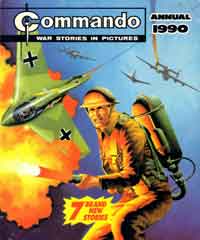
“The second Commando annual came on sale about the time of the shootings at Hungerford and a buyer from WH Smith went on her personal anti-violence crusade, so they wouldn’t carry it.”
The Hurricanes wasn’t a bad comic but it ran for only about 20 issues. It should have been launched to coincide with the start of the TV series but it came out the same week the series ended. Poor distribution didn’t help either. The second Commando annual came on sale about the time of the shootings at Hungerford and a buyer from WH Smith went on her personal anti-violence crusade so they wouldn’t carry it. Sales plummeted and we didn’t do a third.
downthetubes: Hornet and Wizard are not as well known as their siblings Victor and Hotspur. How would you define the difference between Hornet and Wizard and the other boy’s titles of the time?
Bill: I think that Hornet was launched to cash in on the popularity of Victor and Hotspur but I felt it never really had an identity of its own. The name Hotspur was well established and it made the transition from text story paper to picture strips quite well. Victor was easily identifiable by the true life war stories on the front and back covers. The Hornet covers kept changing and I think the title didn’t help. It was really old fashioned. It was pity, because it had some really good stories like the first picture-strip versions of Wilson and “It’s Goals That Count”.
The relaunched Wizard was originally meant to be all colour printed in gravure instead of our usual letter press. But the management took cold feet at the cost and it went out in the usual letter press form. The stories and artwork, with a few exceptions, were poor. The boy’s paper market was declining by the start of the 1970s and Wizard looked tired before it had even hit the streets. Again, an old title didn’t help.
downthetubes: Other than Code-Name Warlord, Union Jack Jackson was the only character to appear in each of the Warlord annuals. Was he the most popular Warlord character with the readers?
Bill: I think it was neck and neck between Union Jack and Code-Name Warlord in the readers’ polls for the entire life of the paper. I preferred Union Jack Jackson. I thought Lord Peter Flint was a pain in the backside.
By the way, Union Jack Jackson first appeared in The Hotspur in 1962 without making much of an impact.
downthetubes: How did you come up with the grittier characters for Warlord such as Heinz Falken, Big Willi, Wolverine and Sergeant Rayker?
Bill: Up until Warlord, the war stories in British comics were nearly all very jingoistic. We tried to get away from that, though we had our battles with management, all of whom had seen service in World War Two. We didn’t want to tell stories about the Brits slaughtering the enemy in amazing feats of derring-do. We wanted to tell stories about all the fighting men in the major conflicts in a more realistic fashion. I have to confess “Code Name Warlord” wasn’t all that realistic, which is why I wasn’t so keen on it.
downthetubes: Free gifts are an integral part of the modern comics, but back in the days of Warlord and the others when they appeared they were a pleasant surprise. These were often paper or generic items, plastic snap together planes and cars for instance, but with Warlord there were some title-specific items, like the Signal Sender or the plastic name tag. Other than at the beginning of a comics run, why were free gifts considered and who came up with the ideas for what was to be given away?
Bill: The tradition of free gifts goes back to the 1920’s, when our text papers used to give away cards featuring famous footballers and other sportsmen. We knew them as “pushes” which papers would have every six months or so. The idea was that lots of kids would buy the paper to get the gift and a fair proportion would like the paper enough to keep buying it.
DC Thomson has a department which sources gifts. Usually, you just took what you were offered but on Warlord we insisted on good gifts which fitted in with the paper’s image. In the first years anyway, we had some cracking free gifts like the collection of famous medals in the first two issues.
downthetubes: IPC’s response to Warlord was Battle Picture Weekly. Was there a satisfaction within the Warlord staff of developing and producing a comic that IPC felt that they had to respond to so quickly?
Bill: I heard a story that the day Warlord came out, the managing editor of IPC called all his boys’ paper editors together and threw a copy of Warlord on the table and told them they had to get out their version as soon as possible. Battle came out about six months later. I hope that story is true. We were certainly chuffed when we heard it! I still think we were better.
downthetubes: In its later issues, Warlord began to reprint its own strips, such as the Union Jack Jackson origin story or the Killer Kane Banshee fighter stor. At what point did this become an option? Were the reprints a cost cutting move in the later issues, and did a certain number of years need to pass before a strip could be reprinted?
Bill: I had moved on from Warlord by the time they started reprinting. It would probably be a way to keep costs down but DC Thomson always had a policy of reprinting popular stories after about seven years. We reckoned that there would be a whole generation of new readers after that time.
downthetubes: The Warlord annuals and summer specials continued on for several years after the weekly title had been amalgamated into Victor. Did the Warlord staff have any input into the annuals or specials and were they, as for instance the Beano annual is today, commissioned so far in advance that their publication was not totally dependent on the continuation of the weekly comic?
Bill: The staff on Warlord/Victor would have had an input into the specials and annuals. You don’t really need a weekly comic to justify an annual. It all depended on sales before Christmas. If there had been a Warlord annual last Christmas and it had sold well, you can bet there would be one this year.
downthetubes: The Crunch had an “agony uncle” in the photographic form of ‘Andy’. Who was Andy? For that matter who was Fireball from Bullet?
Bill: This is where I give away one of the great secrets in DC Thomson. We used a photo of a very young [editor] Euan Kerr! We thought he looked like a really nice guy (which he is).
Fireball was Garry Fraser who was on the staff of Bullet and still works for DC Thomson. He still gets ribbed about being Fireball!
downthetubes: It has been mentioned that the character of Starhawk was inspired by a 1950’s Western story. What led to The Crunch team coming up with the story of Mantracker and its main character Bearpaw Jay, “the Indian warrior who became a Bounty Hunter”?
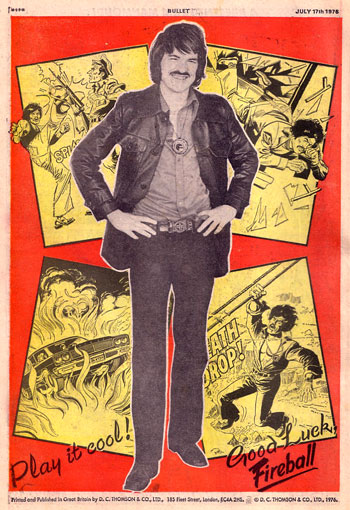
Revealed at last: Fireball from Bullet – in reality, DC Thomson staffer Garry Fraser, who gets ribbed about it to this day…
Mantracker was a completely new character. He wasn’t based on anyone. I just came up with the idea of a modern day bounty hunter who was a Vietnam veteran. This was just a couple of years after the war in Vietnam ended.
downthetubes: In “Ebony”, The Crunch ran the stories of Ebony Jones, a black female secret agent. Was there a female audience for what we would consider to be boy’s comics and, since some issues of The Crunch have letters from girls in the letters pages, was this character an attempt at boosting a female readership?
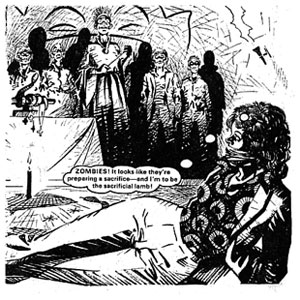
Black secret agent Ebony from The Crunch, originally to have appeared in a very different girls comic to DC Thomson’s usual girls titles, but was never launched.
Bill: In the mid 1970’s I had been involved in the development of a new girls’ paper for DC Thomson. This was going to be totally different from the likes of Bunty and Judy – no ballerinas and ponies, the heroines were going to all-action characters. One of these characters was Ebony Jones.
The paper was abandoned but Ebony was too good to waste, so I brought her into The Crunch. It wasn’t a conscious effort to attract girls as readers.
downthetubes: Some issues of The Crunch have the somewhat cheeky tagline “THE PAPER WITH MAXIMUM THRILL POWER!” Was 2000AD seen as the biggest competitor for The Crunch?
Bill: You know, I had never thought of that before. We used to try and think up different taglines from week to week. I remember we did one which was a spoof of an ad for Pepsi, the one that went – Cool Tastin’, Lip Smackin’ etc… But no, we didn’t see 2000AD as our biggest competitor.
downthetubes: The Crunch never had any annuals or summer specials before it amalgamated into Hotspur but Crunch characters appeared in the 1983 Hotspur annual. Were there plans for a Crunch annual with commissioned stories going into the Hotspur annual instead or were these commissioned directly for Hotspur?
Bill: Crunch never lasted long enough for us to plan an annual. The Hotspur editor at the time would have decided which stories to run in the annual and if he thought that some of the former Crunch characters merited inclusion, he would have had commissioned the stories.
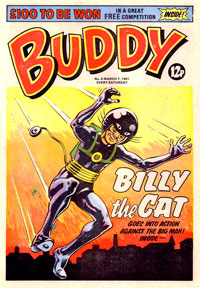
Buddy, a comic aimed at younger readers. This issue featuring Billy the Cat is cover date 8 March 1981.
downthetubes: Was Buddy aimed at a younger audience than The Crunch and the other adventure comics of the time?
Bill: We knew that boys were stopping reading comics at a younger age, so we had to appeal to a younger readership.
downthetubes: Buddy reprinted Beano‘s Jonah in colour on the back cover, as well as featuring stories from many older Beano adventure characters such as General Jumbo and Billy The Cat. Was the reintroduction of Beano characters a deliberate policy to draw in a Beano readership?
Bill: No, it wasn’t. It was simply thought that characters like General Jumbo and Billy The Cat would appeal to the younger reader. We used characters who appeared in some of our other publications who also fitted the bill, like Limp Along Leslie. I was told to put a comic story on the back page and I thought that Jonah was very funny indeed.
downthetubes: Buddy also ran a strip called Young Starhawk based on the earlier adventures of the Starhawk character. The sort of prequel stories seems to be something of a DC Thomson trait with Warlord running Young Wolf for instance, the childhood of the Wolf of Kabul. Was this seen as a way of expanding the characters or more simply a way of creating more stories about popular characters?
Bill: Both really, plus I like prequels and I thought it would be great to learn about the early days of Sol Rynn.
downthetubes: Buddy ran biographical comic strips of a wide range of footballers, actors and entertainers amongst others. Was there a logic to the choice of subject?
Bill: The choice of personalities was solely determined by how easy it was to find biographical material on them!
downthetubes: Why did Spike have such an eclectic range of stories?
Bill: Here’s the story behind Spike. In the the halcyon days of the 1960’s it became the norm for our publications to build up a stock of stories. These would often lie in the cupboard till the editor decided to use them. By the 1980’s, we couldn’t afford to keep such large stocks so it was decided to publish a paper to use some of them up. That was Spike. To beef it up we commissioned some new stories like The Man In Black, which itself was a reworking of Wilson.
downthetubes: Buddy was amalgamated into Victor while Spike was amalgamated into Champ and then Champ went into Victor. How far in advance would such amalgamations be known about within the editorial teams?
Bill: Usually, it would be a month or two. Sometimes it was a lot less. I think I got about two weeks notice that Crunch was going into Hotspur.
downthetubes: Champ has a higher percentage of sports story pages than the earlier titles. After the experiences of Buddy and Spike, were the sports strips seen as being more popular with the audience?
Bill: I think it seemed like Champ had a higher proportion of sports story pages because of the nine-page story “We Are United”. But I don’t recall us making a deliberate decision to make Champ a sports story paper.
downthetubes: IPC never published a long running sporting digest yet DC Thomson’s Football Picture Story Monthly was popular enough to run from 1986 to 2003. Was the concept of a sporting digest seen as a risk at the beginning when there was no direct equivalent from any other publisher?
Bill: I had been advocating we publish a football digest (we called them libraries) since the early 1980’s. I reasoned that the two most popular subjects were football and war. As we already published Commando, why didn’t we do football?
I got nowhere until a note came in from our circulation rep in Cardiff (I think). This guy had noticed that Commando sold well. Why don’t we do a football library? It was enough to make you weep. Anyway, I was given the go-ahead and we launched in time for the 1986 World Cup. I recall we sold out a print run of 42,000. But, like Starblazer, Football PSM suffered from poor distribution. We never gave a thought to what any other publisher was doing.
downthetubes: Football PSM used colour tints in some of it stories in the same way that colour tints were used in some DC Thomson boy’s annuals, but Commando and Starblazer never did. Was the football title aimed at such a different audience to the others that it was seen to need at least some colour?
Bill: No, we just wanted to make the artwork as attractive as possible. But, when sales started to fall, we dropped the colour for cost reasons.
downthetubes: Some issues of Football PSM contained more than one story, not like the IPC combat picture libraries of a 58 page followed by an 8 page story, but more evenly divided on page count. Again, this was not used on Commando and Starblazer. Was there a decision made to try out shorter stories on the readership to see if this increased sales?
Bill: There were two issues of Football PSM every month. One carried a 64 page story, the other carried a 48 page story and a 16 page story. The reason for that is simple. Some stories merited greater length than others. Others were worth only 16 pages.
downthetubes: Football PSM used characters from other DC Thomson titles such as the footballer Jon Stark or the United team, while Starblazer used the Starhawk character in three issues. Commando never used DC Thomson heritage characters in the same way. Were these characters used on the two digests because you had used them in titles you had previously worked on and was it intentional to have recurring characters?
Bill: Yes. I thought these characters were too good to let go to waste. Plus, they were all my characters! We decided to have long running characters in Football PSM. We reasoned that if a character is good, our readers would want more of them. I encouraged the same thing when I took over Starblazer.
downthetubes: Starblazer appears to be one of the most fondly remembered of the various titles that you have worked on and is now being revived to a certain extent with the Starblazer Adventures role playing game. Since it did not have a letters page to encourage the readers to write in, did it get letters and other feedback from its readership?
Bill: We did get some feedback, but not a lot.
downthetubes: How did Starblazer come about?
Bill: I spoke to my old friend and colleague, Bill McLoughlin, about the origins of Starblazer. He was in on it from the beginning.
Back in the late 1970’s, a man called Jack Smith was the editor of the My Weekly libraries, a spin-off from the DC Thomson weekly women’s magazine of the same name, full of couthy stories for ladies. Jack was a great Sci-Fi fan and, according to Bill McLoughlin, he went to his boss, Gordon Small, and suggested we publish science fiction in picture strip form. Jack got the go ahead and Starblazer was born.
Now here is the weird thing. Gordon Small was the managing editor of DC Thomson’s women’s publications department and Jack worked for him. So Starblazer was officially part of our women’s department! Bill was actually transferred from the children’s department to become Jack’s Number Two.
Bill thinks Starblazer was a working title which just sort of stuck. It was almost certainly inspired by Star Wars.
downthetubes: How did you become editor?
Bill: Jack took early retirement in 1985 due to ill health and, when Starblazer was moved into the children’s department, I took over as editor. Bill McLoughlin remained on Starblazer as my deputy.
downthetubes: Are there any stories you remember particularly and if so, why?
Bill: I could go on and on about the stories I remember but here are just a few – The Ardarian Knight, written and drawn by Casanovas Junior, The Robot Kid series written by Mike Chinn and drawn by Garijo and the Carter stories, first written by Mike Knowles and later by Dave Taylor and Alan Hemus and illustrated by Casanovas Junior. All were very well written and brilliantly drawn.
Oh, and everything illustrated by Enrique Alcatena. What an artist!
downthetubes: Perhaps the most unusual thing to happen with Starblazer was the publication of a credit listing for all its issues in its final days. Since this listing seems to be unique within DC Thomson, why was it done and was it something that was important to the editorial team to do perhaps as a thank-you to the artists and writers?
Bill: That’s right. I thought it was important that we acknowledged all these talented people. And I have been agitating for the last couple of years for us to put out the Best Of Starblazer, pretty much as we did with Commando. I am convinced there is a market for it. There is some wonderful stuff that people never got the chance to see.
downthetubes: DC Thomson’s girl’s titles are generally poorly documented in comparison to the boy’s. Was there a cross over of writers and artists between the boy’s and girl’s digests or was there an obvious demarcation, say between artists who were best at football, tanks, aircraft or horses?
Bill: Obviously, there are artists who are more comfortable with subjects like war and sport amd the same goes for writers. But you might be surprised by the number of writers and artists who can handle both.
The most prolific writer of picture stories scripts that I knew was the late Ron Carpenter. He wrote just as easily for Warlord as he did for Bunty. Ron churned out high quality scripts — boy’s and girl’s — for us for years and he still found time to write for IPC.
Barrie Mitchell is, in my opinion, the best football artist ever. Yet, now he draws Wendy strips for me. I could go on and on.
downthetubes: Writer Pat Mills once noted that girls’ comics were better written than boys’ comics because the former could rely less on violence to move a story forward. Do you think that girls’ comics were better written than boys’ comics?
Bill: No. Since I started editing Wendy I have read quite a few of the girl’s stories published over the years. They are often mind-numbingly repetitive and the plots are full of holes and amazing coincidences.
Here’s the typical girls’ story plot. Girl is happy. Circumstances change and girl is miserable. Unexpected benefactor appears and girl is happy again. That’s why I think Wendy has been so successful. I, and many of the staff in the early years, were trained on boys’ papers. The stories are better plotted with two or three story lines in each episode – and there is very little violence.
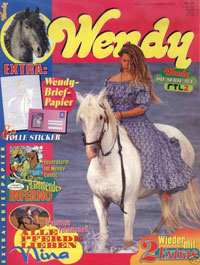
Wendy could be regarded as DC Thomson’s surviving girl’s title, even though it is published by Egmont – and only on the continent.
downthetubes: Wendy is one of those titles that often gets a passing mention by artists working on it but, being published outside the UK, little is known about it here. Where is Wendy published and for how long has it been going?
Bill: Wendy is published weekly in Germany and fortnightly in Denmark, Sweden and Norway by the various arms of Egmont. It is also published under licence under other titles in France and Holland (I think quarterly). The magazine called Wendy was first published in Germany in 1986, using stories reprinted from our girls’ papers. The character Wendy first appeared in 1991.
You are right about it being little known in this country. I had a phone call asking me what Wendy was just last week. And that was someone working in another department of DC Thomson! I am not kidding.
Wendy is huge in the territories where it is published. Along with the magazine there is considerable marketing. A range of toys based on the characters was launched last Christmas and I believe it won Toy Of The Year in Germany.
downthetubes: What artists have worked on, and currently work on, Wendy?
Three English artists have worked on the story: Barrie Mitchell, Jim Colthorpe and the late Phil Gascoine. The rest are all Spanish: Jaume Forns, Rodrigo Comos, Jesus Pena, Antonio Perez and his son David, and Joaquin Romero are all currently working on the strip. We’ve also used Rojo, Roca, Blase and Redondo.
downthetubes: With Wendy you continue to originate British comic strips albeit for foreign markets. Do you have any ideas on why the British comics market is in such a parlous state nowadays?
Bill: There are several reasons. The standard of literacy in children in this country is appalling. If you can’t read, then you can’t read comics. I was reading text story papers when I was still in primary school. One of my staff has an honours degree in English but she admitted she has learned more about grammar and spelling working with me.
24 hour television hasn’t helped. Kids can watch cartoons all day long. And computer games are so realistic nowadays that kids can act out adventures rather than read about them.
Then there is the domination of the supermarkets. Publishers have to pay them to get their publications on their shelves. In the old days, you could just go round to your local paper shop and buy your comics.
downthetubes: What is the best thing about working for DC Thomson?
Bill: I have described what it used to be like working here earlier, but it’s not like that now. The best thing is the people. Great comic talents like Euan Kerr and Morris Heggie, previous editors of The Beano and Dandy. And Martin Lindsay, who is now our licensing manager but who was a very talented sub-editor, especially on football stories. And, of course, our office five a side football game which has been going on every Wednesday for over thirty years!d
downthetubes: … and the worst?
Bill: There isn’t the same atmosphere there once was in the office. It is like working in what I imagine an “ordinary” office must be like. We seem to be obsessed with spread sheets, budgets, human resources etc. Last autumn I was sent on a management training course. I’ve only been an editor for thirty years!
I suppose I’m a bit of a dinosaur these days. Apart from Wendy and Commando, we don’t produce picture stories. Let’s face it, the market isn’t there any more.
 downthetubes: What is your favourite of all the comics you worked on and is there a title that stands out as being the one that you are the most proud of?
downthetubes: What is your favourite of all the comics you worked on and is there a title that stands out as being the one that you are the most proud of?
Bill: It is almost impossible to choose between Starblazer and Warlord. I believe we changed the face of boys’ papers in Britain with Warlord and opened up the way for Battle and 2000AD. Up until then, boys’ papers would have up to 12 or 13 pictures on a page.
The first editor of Warlord, Pete Clark, had great visual flair. He introduced the big opening frames, some taking up the whole page, and cut the number of frames per page to 6 or 7. The artists could then produce great action-packed scenes, ideal for war stories. I really enjoyed a lot of the stories such as Kampfgruppe Falken and Union Jack Jackson.
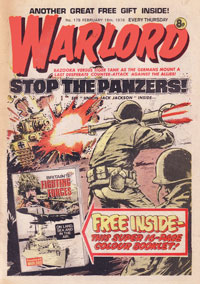 Before I took over Starblazer, it was purely sci fi. I thought we were missing out on a lot of good story material so I introduced the fantasy element — sword and sorcery. It was a pleasure so work with artists like Alcatena, Ian Kennedy, Colin McNeil and Casanovas Junior plus writers like Mike Chinn, Alan Hemus and David Taylor. I am proud of a lot of the work I did, along with Bill McLoughlin, on Starblazer.
Before I took over Starblazer, it was purely sci fi. I thought we were missing out on a lot of good story material so I introduced the fantasy element — sword and sorcery. It was a pleasure so work with artists like Alcatena, Ian Kennedy, Colin McNeil and Casanovas Junior plus writers like Mike Chinn, Alan Hemus and David Taylor. I am proud of a lot of the work I did, along with Bill McLoughlin, on Starblazer.
I am proud of the fact that the Wendy stories have been so successful over the years but my favourite is Warlord. My happiest time in this business was when I was the editor of that title.
Bill, thanks very much for your time and your work in British comics.
Additional questions by Matthew Badham, John Freeman and Colin Noble
External Links
Buddy
• 26pigs.com/buddy
The Crunch
• 26pigs.com/crunch
Football PSM
• www.britishcomics.20m.com/foottitles.htm
• www.britishcomics.20m.com/foot1986-1988.htm
• www.britishcomics.20m.com/foot1989-1991.htm
Hornet
• 26pigs.com/hornet
Warlord
• 26pigs.com/warlord
Wizard
• 26pigs.com/wizard
This link is mainly about the original story paper version rather than the comic strip version

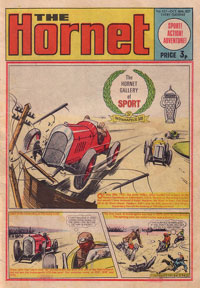

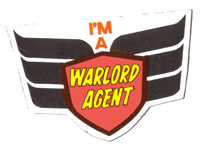
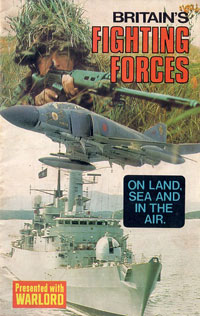


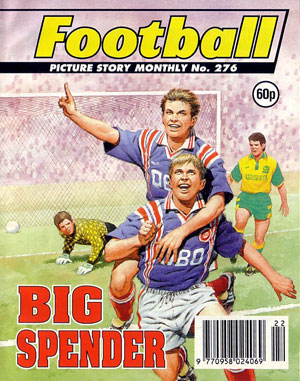
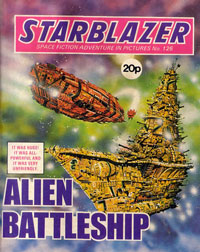
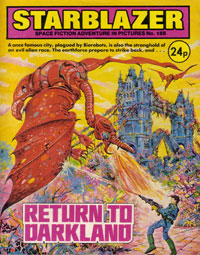
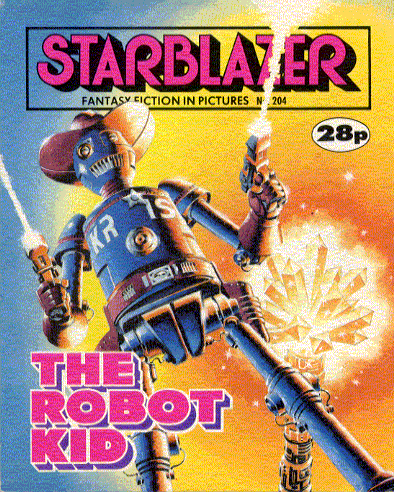
Leave a Reply to Battlegroup Niffleheim: Abode of The Dead | nothingbutafan Cancel reply